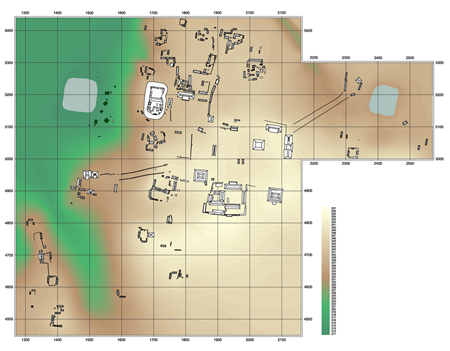Maya Pool the Size of a Football Field Discovered in Uxul, Mexico
 Archaeologists digging at the ancient Maya city of Uxul, Mexico, have located an artificial lake the size of a football field. The two metres deep pool – its floor a mosaic of ceramic shards – was constructed about 1,500 years ago.
Archaeologists digging at the ancient Maya city of Uxul, Mexico, have located an artificial lake the size of a football field. The two metres deep pool – its floor a mosaic of ceramic shards – was constructed about 1,500 years ago.
Uxul is located on the Mexican Yucatán Peninsula, near the Guatamalan border and only twentysix kilometres southwest of Unesco World Heritage Site Calakmul. German and Mexican archaeologists started systematically excavating and mapping its ruins in 2009.
“In doing so, we stumbled upon two square water reservoirs, each about 100 metres by 100 metres,” says Dr Iken Paap from the University of Bonn.
Massive pools for storing drinking water – called 'aguadas' – are well known from other Maya cities. What makes these newly discovered reservoirs and exceptional find, is that the Uxul peoples seem to have devised an ingenious – and previously unkown – way to seal their water storage systems.
“We've carried out a trial excavation, right in the middle of one of the reservoirs,” explains Nicolaus Seefeld. “We found that the floor, at two metres deep, was almost completely covered with ceramic shards – probably pottery fragments. If it is like this throughout the entire aguada, we don't know yet.”

Click the map to see a larger version. The two artificial lakes are marked in blue on this map of Uxul's ruins. Both measure about 100x100 metres (a football field is about 90 by 120 metres.) - Image copyright Institute for Ancient American Studies, University of Bonn.
If so, the pools are an extraordinary find – not at least because of the sheer amount of pottery needed; each of the Uxul aguadas could contain approximately ten Olympic swimming pools.
It is possible future excavations will reveal additional reservoirs. The aguadas needed to store enough water for Uxul's more than 2,000 residents to make it through the three-month dry season.
The German-Mexican excavation team also found Uxul's first intact graves.
“From these, and new research on the water provisions and vegetation history, we expect to gain new insights into the inhabitants of this Maya city,” says Bonn University's Dr Nikolai Grube.
All burials found so far were destroyed by grave robbers in search for pottery or jade.
Analysis of the different layers at Uxul shows it was populated throughout the different periods of Maya civilization. “We excavated more than three meters deep, revealing a sequence of layers ranging from the late Preclassic to the late Classic or Postclassic period," tells Dr Paap. Inscriptions have revealed that around 630 AD, the city of Uxul was annexed to the kingdom of Calakmul.
The name 'Uxul', meaning 'at the end', was given to the city by explorers Karl Ruppert and John Denison when they – tired and ill after a long expedition through the Yucan Peninsula's rainforest – discovered the ruins in 1934. Not much has changed since the thirties; Uxul is still at the end of the world, far away from modern roads and cities (photographs from the 2010 excavation season seem to confirm this).
“To reach the ruins, it takes travelling 120km of jungle paths through the Calakmul Biosphere Reserve,” explains Dr Iken.
A thousand years ago, Uxul wasn't isolated at all. Excellently positioned between the great Mayan cities of El Mirador in the South and Clakmul, the city was trading as far as modern-day southern Guatemala and the highlands of central Mexico.
Read 2 comments, or leave your own
Latest
 Get Real About Advertising Fakes ASA Tells Semmel Concerts King Tut Tour
Get Real About Advertising Fakes ASA Tells Semmel Concerts King Tut Tour- Unique Iron Age Hoard goes on display at Ipswich Museum
- Missing the revolution but making the party!
- Royal Artefacts - Including King Tut's Golden Trumpet - Returned to Egyptian Museum Cairo
 SCA releases full list of treasures missing from the Cairo Museum
SCA releases full list of treasures missing from the Cairo Museum- Petrie Museum celebrates the extraordinary life of Amelia Edwards
- New Face for 5,300-year-old Otzi the Iceman
- New Clues to Welsh Origins of Stonehenge Bluestones
- Read latest articles, blogs & reviews
Most Popular
- Standing Stones and Other Sun Traps: 10 British Sites With Astronomical Alignments
- Mike Parker-Pearson on Bluestonehenge and other recent results from The Stonehenge Riverside Project
- Alternatives to Stonehenge: 10 Places to Celebrate the Summer Solstice
- Top 10 People to Look Out for at Stonehenge Summer Solstice 2010
History Library
HK Editor's Picks


Latest Comments
 hello this is a real interesting article on forgeries
hello this is a real interesting article on forgeries
 excellent article !
excellent article !
 Museum looks really great.
ediscovery
Museum looks really great.
ediscovery
 There are really lots of secrets in Egypt. I'm sure this is going to cost millions in auction.
e-discovery tools to help your business grow efficiently.
There are really lots of secrets in Egypt. I'm sure this is going to cost millions in auction.
e-discovery tools to help your business grow efficiently.
Focus on
King Tut –
Stonehenge
Terracotta Warriors
Pyramids –
Archaeology
Britain –
China –
Egypt
Greece –
Rome
Heritage Key Words
ancient london, british museum, roman, art, zahi hawass, london, ancient egypt, religion, burial, valley of the kings
Next major 'ancient' exhibition in London:
Journey Through the Afterlife: The Ancient Egyptian Book of the Dead
at the British Museum
November 2010 - March 2011
(learn more)





















 videos
videos

Comments
With the archeologist find, we can conclude that the mayan civilization is one of the ancient people who inhabited our planet with high intelligence.
<p>so good</p>